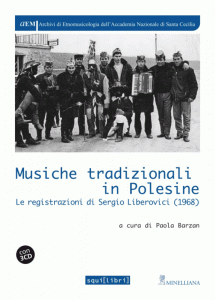 It will be released on September 18 – but you can already order online at a reduced price – the new volume of the AEM-Archives of Ethnomusicology. It is “Traditional music in Polesine. Recordings by Sergio Liberovici (1968), edited by Paola Barzan, with contributions from Chiara Crepaldi, Flavia Giacchero, Febo Guizzi and Paolo Ragni. The purpose of the publication is to bring out – within a critic and theorist framework – the panorama of oral tradition music of our country, through the study of repertoires documented by ethnomusicologists and researchers since the fifties. As is the tradition of the series (for which, among others, have already come out volumes on Umbria, Molise, Salento, Calabria, Abruzzo and Basilicata), dedicated to the historical records of the Italian ethnomusicological repertoire, organized in regions or geographical areas, even in this new book are accompanied by the original audio documents, conveyed in three CDs. As specifies the title, the output volume refers to the documentation work done by Sergio Liberovici – composer and musician who died in 1991 – during a campaign of documentation in “a reality irreducible to their horizon of meaning, forged in vivo experiments strongly oriented by an ideological point of view, from Cantacronache to the research conducted together with Emilio Jona singing on social and workers’ memories”. In the Po delta Liberovici raised more than two hundred documents, kept in the collection 117 of the Archives of Ethnomusicology of the Academy of Santa Cecilia, including several songs sung by former weeders, tavern songs, spontaneous choruses, ballads of storytellers, Venetian “villotte”. Taken together, the sound documents well represent the cultural and social fragmentation of the study area (divided between Ca ‘Camerini, Ca’ Venier and Donzella), which can be considered a meeting place where converge various expressive traditions, but also marked by archaic and backwardness elements, “both in terms of life and in class consciousness”.
It will be released on September 18 – but you can already order online at a reduced price – the new volume of the AEM-Archives of Ethnomusicology. It is “Traditional music in Polesine. Recordings by Sergio Liberovici (1968), edited by Paola Barzan, with contributions from Chiara Crepaldi, Flavia Giacchero, Febo Guizzi and Paolo Ragni. The purpose of the publication is to bring out – within a critic and theorist framework – the panorama of oral tradition music of our country, through the study of repertoires documented by ethnomusicologists and researchers since the fifties. As is the tradition of the series (for which, among others, have already come out volumes on Umbria, Molise, Salento, Calabria, Abruzzo and Basilicata), dedicated to the historical records of the Italian ethnomusicological repertoire, organized in regions or geographical areas, even in this new book are accompanied by the original audio documents, conveyed in three CDs. As specifies the title, the output volume refers to the documentation work done by Sergio Liberovici – composer and musician who died in 1991 – during a campaign of documentation in “a reality irreducible to their horizon of meaning, forged in vivo experiments strongly oriented by an ideological point of view, from Cantacronache to the research conducted together with Emilio Jona singing on social and workers’ memories”. In the Po delta Liberovici raised more than two hundred documents, kept in the collection 117 of the Archives of Ethnomusicology of the Academy of Santa Cecilia, including several songs sung by former weeders, tavern songs, spontaneous choruses, ballads of storytellers, Venetian “villotte”. Taken together, the sound documents well represent the cultural and social fragmentation of the study area (divided between Ca ‘Camerini, Ca’ Venier and Donzella), which can be considered a meeting place where converge various expressive traditions, but also marked by archaic and backwardness elements, “both in terms of life and in class consciousness”.
Here you can listen ” Ai sei di genaio è qui la vecia” – one of about eighty songs contained in the records – and read an extract from the introduction to the volume.
Questo post è disponibile anche in: Italian

 English
English Italiano
Italiano 





Leave a comment
You must be logged in to post a comment.